Can You Put a Longer Bar on a Chainsaw?
- January 30, 2024
- 0 comment
When it comes to modifying your chainsaw by adding a longer bar, the answer is both yes and no. It’s not as simple as just attaching any longer bar and expecting your chainsaw to function optimally. Specific criteria must be met for the chainsaw to operate safely and efficiently. These include compatibility with the chainsaw’s engine size, bar size, chain size, and sprocket.
Understanding the Compatibility
- Chainsaws require a certain amount of power, depending on their engine size, to operate different bar lengths effectively. The general rule of thumb is that the larger the engine (measured in cubic centimeters (CC) for gas, volts for battery-powered, and amps for electric chainsaws), the longer the bar it can potentially handle.
- The chain must match the new bar in terms of length and size to ensure proper functionality.
- The sprocket must fit the chain to ensure that the power from the engine is efficiently transferred to the chain, allowing for effective cutting.
| Chainsaw Type | Power Rating | Recommended Bar Length |
|---|---|---|
| Gas-powered | Less than 25 cc | 10-12” |
| Gas-powered | 26-35 cc | 12-16” |
| Gas-powered | 36-45 cc | 14-20” |
| Gas-powered | 46-60 cc | 16-24” |
| Gas-powered | 60-75 cc | 18-28” |
| Gas-powered | 76-90 cc | 20-32” |
| Gas-powered | 91-100 cc | 24-36” |
| Gas-powered | 100-115 cc | 26-50” |
| Gas-powered | More than 116 cc | 28-84” |
| Battery-powered | 18-20 Volts | 10-12″ |
| Battery-powered | 24-30 Volts | 10-14″ |
| Battery-powered | 36-40 Volts | 10-16″ |
| Battery-powered | 40-50 Volts | 12-18″ |
| Battery-powered | 50-60 Volts | 12-20″ |
| Corded Electric | 8-12 Amps | 10-16″ |
| Corded Electric | 13-15 Amps | 12-18″ |
Verifying the Possibility
- Not all chainsaws can handle a longer bar. It’s crucial to understand the power source and capacity of your chainsaw. A 55 CC chainsaw, for instance, typically comes with a 20-inch bar. Some models may handle a 2 to 4-inch increase in bar length, but beyond that, the engine may not provide enough power to efficiently run a longer bar, especially for cutting large pieces of wood.
- The most reliable source for information on compatible bar lengths is the chainsaw’s user manual. It may not be the most exciting read, but it contains vital information. You can easily find the manual online by searching for your chainsaw’s model followed by “User Manual.” Use the search function (CTRL + F or CMD + F) to find specific information about bar lengths.
Case Study
An interesting case is the Husqvarna 266, commonly used in North Vancouver Island for tree pruning. While it’s sold with a 20-inch bar, it’s commonly upgraded to a 24-inch bar due to its 66 CC engine capacity.
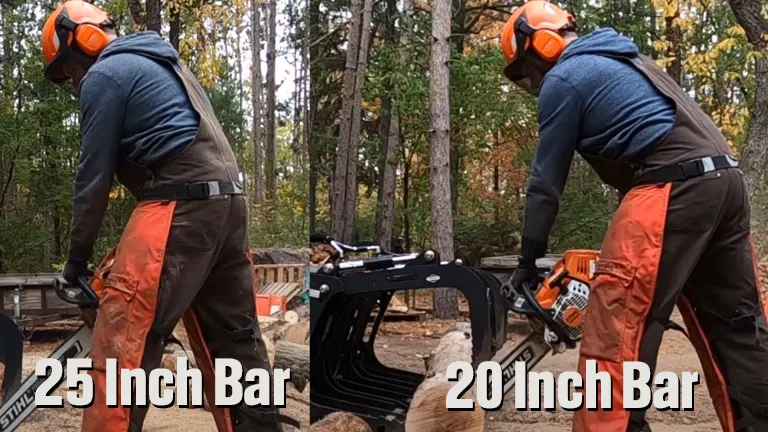
Some operators even used 32-inch bars not for cutting large logs but for cutting small saplings at ground level without bending over. However, it’s important to note that using excessively long bars can lead to mechanical issues, such as cracked crankcases, due to the increased leverage and strain on the chainsaw.
Understanding the Use of Long Chainsaw Bars
Long chainsaw bars serve a specialized and essential role, particularly in chainsaw milling. The main advantage of these elongated bars lies in their ability to cut wide slabs of wood, which is a significant benefit for milling operations. The length of the bar directly correlates to the width of the slab that can be cut, making it much more efficient to work with large logs. This efficiency is not just about the size of the cut but also about minimizing the need for repositioning and multiple cuts, thus saving time and effort.
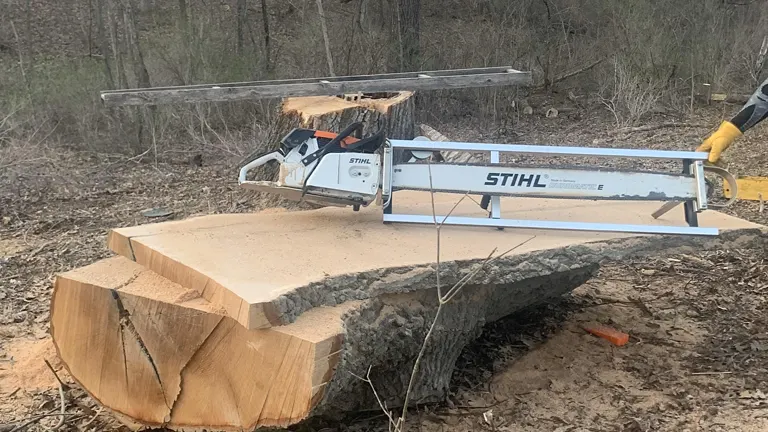
The convenience of using long chainsaw bars extends beyond their cutting capabilities. One of the key benefits is the reduced physical strain on the operator. Since these bars can handle large logs, there’s less need for the operator to move around or reposition the log repeatedly. This not only makes the milling process smoother but also less physically demanding. Additionally, the ability to cut larger sections of wood in a single, fluid motion streamlines the entire milling process, making it more efficient and less time-consuming.

For those involved in large-scale milling jobs, a long chainsaw bar is not just a luxury; it’s a necessity. These jobs often involve handling massive logs that smaller bars simply cannot accommodate. To effectively manage such tasks, a long bar is crucial. However, it’s important to note that to maximize the performance of a long chainsaw bar, it should ideally be used in conjunction with a suitable chainsaw mill. This combination ensures that you can tackle large-scale jobs with the precision and efficiency required in professional milling operations.
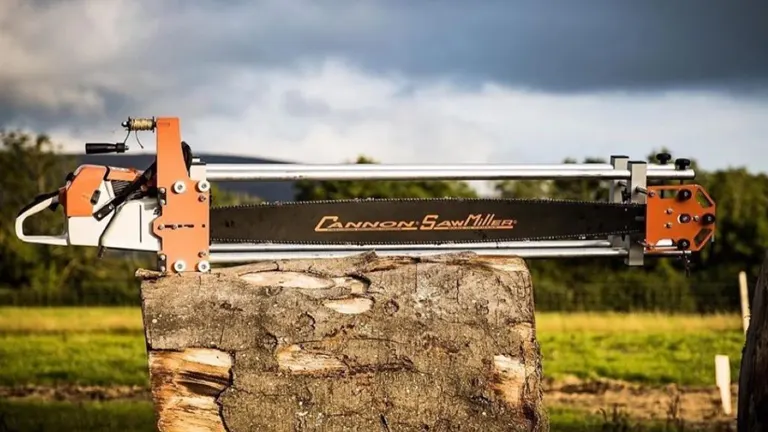
In conclusion, long chainsaw bars are indispensable tools in the realm of chainsaw milling. Their ability to handle large logs, reduce physical strain, and streamline the milling process makes them an invaluable asset for anyone involved in large-scale milling operations. When paired with the right chainsaw mill, a long chainsaw bar can significantly enhance your milling efficiency and effectiveness.
Tips for Using a Longer Bar on Your Chainsaw
Using a longer bar on your chainsaw can significantly enhance your cutting capabilities, especially for large-scale operations. However, it’s crucial to use it correctly to ensure safety and prolong the life of your chainsaw. Here are some detailed tips for using a longer bar effectively:
- Adjusting the Rakers (depth gauges) a bit higher than usual can reduce the strain on the chainsaw when using a longer bar. This ensures a smoother cut and less stress on the engine, especially during extended use.
- A full skip chain, which has fewer teeth, can be beneficial when using a longer bar. This type of chain reduces the load on the powerhead, making it easier for the chainsaw to manage the additional length without compromising on performance.
- The chainsaw’s oiler must be capable of lubricating the longer bar and chain adequately. A consistent and sufficient oil supply is crucial to prevent overheating, which can cause significant damage to both the bar and the chain.
- When doing wedge work while falling, always ‘dog’ your chainsaw into the tree. This means securely anchoring it to prevent unnecessary vibration and pressure on the chainsaw bar. Vibration can lead to bars cracking at the rails, especially a couple of inches away from where the chainsaw dogs are located, due to the stress it causes.
- Regular maintenance is key. Each time you remove your chain for sharpening, take the opportunity to clean the chainsaw bar groove and oil holes using a groove cleaner or narrow screwdriver. Additionally, flip your chainsaw bar periodically to ensure even wear on both sides. This practice prolongs the life of the bar and maintains its efficiency.
- The drive sprocket should be replaced every three chains to maintain optimal performance. Avoid using a used chain on a new drive sprocket and vice versa. This ensures that the sprocket and chain wear evenly and reduces the risk of damage.
- It’s crucial to use the bar correctly. Never use it as a lever to pry, twist, or lift the wood you are working with. Such actions can cause the bar rails to crack or the bar to bend, leading to potential safety hazards and decreased efficiency.
The Longest Chainsaw Bars on the Market
For those in the professional milling industry or anyone curious about the extremes of chainsaw capabilities, the lengths of the longest chainsaw bars available are quite astounding. Here’s a detailed look at some of the longest chainsaw bars offered by various brands:
The Record Holder

- The title for the longest chainsaw bar goes to Cannon, with a massive 120-inch (10 feet) bar. This double-ended bar sets the standard for what’s possible in chainsaw milling.
- Cannon doesn’t stop there; they also list a 144-inch bar on their website, available upon request, pushing the boundaries even further.
List of Longest Chainsaw Bars
Here’s a detailed rundown of the longest chainsaw bars from reputable brands:
| Brand | Model | Type | Length |
|---|---|---|---|
| Cannon | CDE-G1-120-63 | Double Ended | 120” |
| Cannon | CDE-G1-108-63 | Double Ended | 108” |
| Granberg | G741-96HSD | Double Ended | 96” |
| Cannon | CDE-G1-96-63 | Double Ended | 96” |
| Granberg | G741-84HS-63RQ | Single Ended | 84” |
| Granberg | G741-84HSD | Double Ended | 84” |
| Cannon | CDE-G1-84-63 | Double Ended | 84” |
| Granberg | G741-74HS-63RQ | Single Ended | 74” |
| Granberg | G741-72HSD | Double Ended | 72” |
| Cannon | CDE-G1-72-63 | Double Ended | 72” |
| Granberg | G741-66HSD | Double Ended | 66” |
| Cannon | CDE-G1-66-63 | Double Ended | 66” |
The Longest Chainsaw Bars by Stihl and Husqvarna
Stihl’s Longest Bar

Stihl offers the Rollomatic Super E guide bar, stretching up to 59 inches, designed for their powerful MS 880 & 881 models. Known for its durability and high-grade steel, it’s built to last.
Husqvarna’s Longest Bar

Husqvarna doesn’t lag far behind, with the Pro Titanium Professional Roller Tip (HTR-343) as their longest, reaching up to 72 inches. Available also in 60 inches and 44 inches, these bars are tailored for high-powered professional chainsaws.
How to Choose the Right Bar Length for Your Chainsaw
Selecting the appropriate bar length for your chainsaw is crucial for efficient, safe, and comfortable operation. Here’s a comprehensive guide to help you make the right choice:
1. Understand the Power of Your Chainsaw
The fundamental rule is straightforward: the more powerful your chainsaw, the longer the bar it can accommodate. Manufacturers typically provide a recommended bar length for each model, tailored to its power output. You’ll find this information in the “Specifications” or “Technical Data” section of your chainsaw’s user manual.
2. Consider the Type of Wood You’re Cutting
The wood type plays a significant role in choosing the appropriate bar length.
- Hardwood Cutting (e.g., oak, maple): Hardwood requires more power to cut through. Opting for a shorter bar is advisable, as a longer bar can reduce the efficiency of your chainsaw when dealing with such dense materials.
- Softwood Cutting (e.g., pine, fir): Softwoods are less demanding on your chainsaw. If you predominantly cut softwood, you can comfortably use a slightly longer bar, as these materials don’t require the same power level for cutting.
3. Balance & Maneuverability
A well-balanced chainsaw is essential for control and precision.
- Weight Considerations: Be mindful that increasing the bar length adds weight to your chainsaw. For instance, opting for a 32″ bar might add up to 5 lbs, affecting the tool’s balance and your ability to maneuver it smoothly.
- Handling: A heavier and longer bar might make the chainsaw feel unwieldy. If ease of handling is a priority, you might want to stick to a shorter bar, especially for tasks requiring precision and control.
| Bar Length | Added Weight |
|---|---|
| 16″ | 1-1.5 LBs |
| 18″ | 2-2.5 LBs |
| 20″ | 2.5-3 LBs |
| 24″ | 3-3.5 LBs |
| 28″ | 3-4 LBs |
| 32″ | 3.5-5 LBs |
| 34″ | 4-5.5 LBs |
4. Reach
For tasks involving cutting logs or branches at a height or distance:
- Extended Reach: A longer bar offers extended reach, allowing you to cut distant logs or branches without the need to move around excessively.
- Reduced Strain: By enabling you to stand in a single spot and reach farther, a longer bar can significantly reduce the strain on your back, making it easier to work for extended periods.
5. Cost
The price of the chainsaw bar is directly proportional to its length.
- Longer bars generally cost more. For example, while an 18″ bar might cost around $55, a 24″ bar might be priced at $65 or higher. It’s essential to consider the cost factor and balance it with your specific needs and the frequency of use.
Conclusion
While you can put a longer bar on a chainsaw, it’s crucial to ensure that the bar, chain, and sprocket are compatible with the chainsaw’s engine size and power capacity. Always refer to the manufacturer’s manual for guidance, and consider the physical and mechanical implications of using a longer bar. By adhering to these guidelines, you can ensure the safe and efficient operation of your chainsaw.
FAQs
- What determines the maximum bar length my chainsaw can handle?
The maximum bar length your chainsaw can handle is primarily determined by the chainsaw’s engine power (measured in CC, volts, or amps depending on the type) and the manufacturer’s specifications. Additionally, factors like the chainsaw’s design, balance, and the user’s ability to handle the added weight and size also play a role. - Can I use a chainsaw with an extra-long bar for regular tree cutting, not just milling?
While it’s technically possible, using an extra-long bar for regular tree cutting is not recommended. Extra-long bars are designed for milling and can be unwieldy and unsafe for regular cutting tasks due to their size and the difficulty in maneuvering them. - How do I maintain my chainsaw bar to ensure it lasts longer?
Regular maintenance includes cleaning the bar groove and oil holes every time you remove the chain, flipping the bar periodically to ensure even wear, checking and adjusting the tension of the chain regularly, and storing the chainsaw in a dry, clean place to prevent rust and corrosion. - Are there any safety gear recommendations when using chainsaws with long bars?
Yes, it’s crucial to wear appropriate safety gear, including a hard hat, safety goggles, ear protection, gloves, cut-resistant pants or chaps, and steel-toed boots. The increased length and weight of the bar require extra caution, making protective gear even more important. - How does the type of wood I’m cutting influence the choice of bar length?
The type of wood influences the required power and bar length. Hardwoods require more power and typically a shorter bar to maintain cutting efficiency, while softwoods can be cut with a longer bar as they require less power. - What are the signs that a chainsaw bar needs to be replaced?
Signs include visible wear such as bending or warping of the bar, signs of overheating like blue discoloration, worn out rails, or a groove that’s too wide for the chain to sit snugly, resulting in poor cutting performance. - Can I interchange bars and chains between different chainsaw brands?
While some bars and chains may be interchangeable, it’s essential to check compatibility based on the size, length, and mount type. Always refer to the manufacturer’s specifications or consult with a professional to ensure compatibility and safe operation.
Your insights matter! Share your chainsaw experiences, tips, or reviews below and help guide fellow woodcutting enthusiasts. Together, let’s create a knowledgeable community where everyone can make informed, confident chainsaw choices.

David Murray
Forestry AuthorI'm David Murry, a forestry equipment specialist with a focus on chainsaw operation. With over 13 years of experience, I've honed my skills in operating and maintaining a wide range of machinery, from chainsaws to log splitters. My passion for the outdoors and commitment to sustainable forestry drive my work, which emphasizes safety, efficiency, and staying updated with industry advancements. Additionally, I'm dedicated to sharing my expertise and promoting environmental awareness within the forestry community.




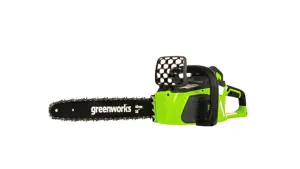
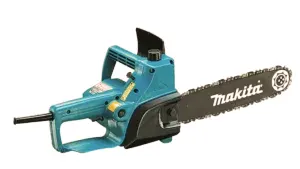
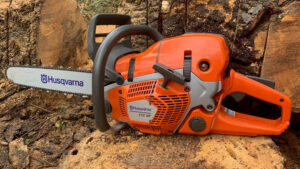
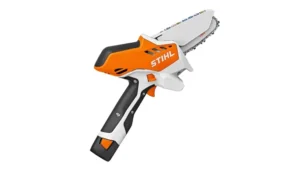

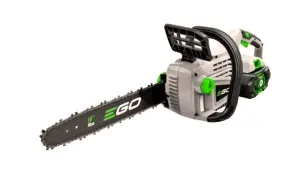
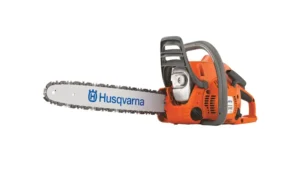
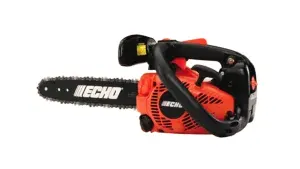
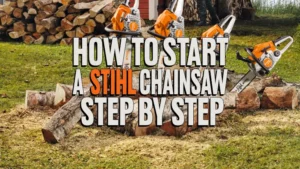
Leave your comment